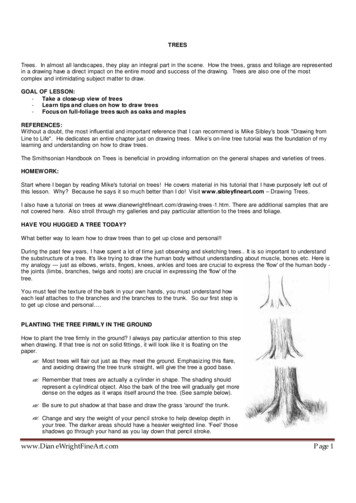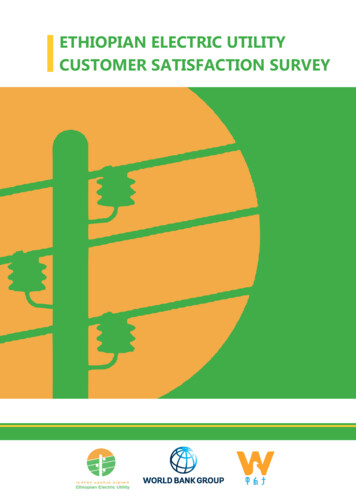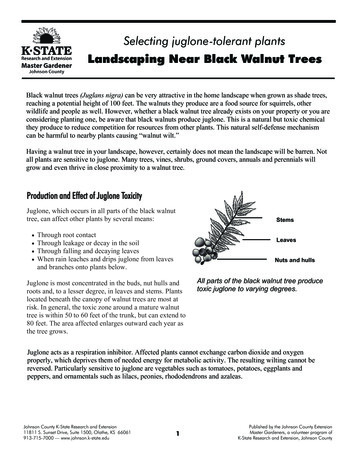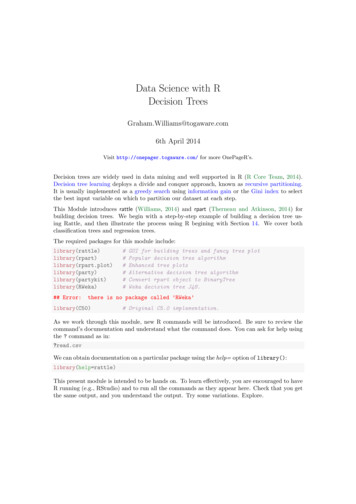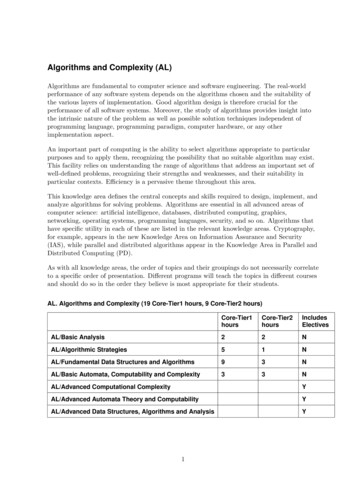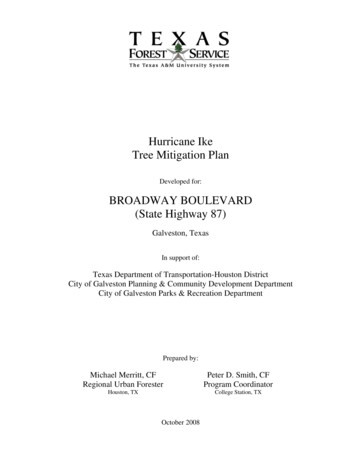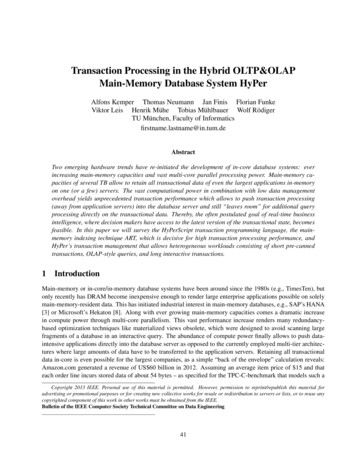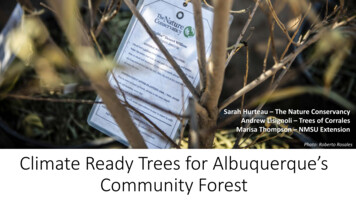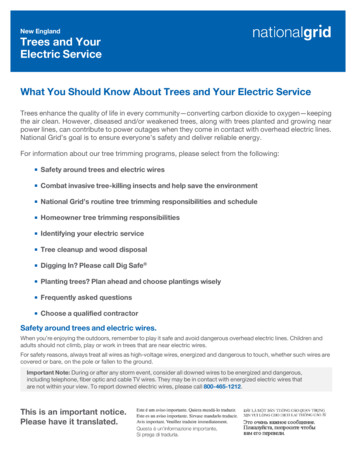
Transcription
New EnglandTrees and YourElectric ServiceWhat You Should Know About Trees and Your Electric ServiceTrees enhance the quality of life in every community—converting carbon dioxide to oxygen—keepingthe air clean. However, diseased and/or weakened trees, along with trees planted and growing nearpower lines, can contribute to power outages when they come in contact with overhead electric lines.National Grid’s goal is to ensure everyone’s safety and deliver reliable energy.For information about our tree trimming programs, please select from the following:Safety around trees and electric wiresCombat invasive tree-killing insects and help save the environmentNational Grid’s routine tree trimming responsibilities and scheduleHomeowner tree trimming responsibilitiesIdentifying your electric serviceTree cleanup and wood disposalDigging In? Please call Dig Safe Planting trees? Plan ahead and choose plantings wiselyFrequently asked questionsChoose a qualified contractorSafety around trees and electric wires.When you’re enjoying the outdoors, remember to play it safe and avoid dangerous overhead electric lines. Children andadults should not climb, play or work in trees that are near electric wires.For safety reasons, always treat all wires as high-voltage wires, energized and dangerous to touch, whether such wires arecovered or bare, on the pole or fallen to the ground.Important Note: During or after any storm event, consider all downed wires to be energized and dangerous,including telephone, fiber optic and cable TV wires. They may be in contact with energized electric wires thatare not within your view. To report downed electric wires, please call 800-465-1212.This is an important notice.Please have it translated.
New EnglandTrees and YourElectric ServiceCombat invasive tree-killing insects and help save the environment.Look for and report these symptoms:Asian Long-Horned Beetle – 3/8 inch round exit holes on the trunk and branches, sawdust and sapon and around thetrees, round pits in the bark (egg niches), often on maple, horse chestnut, birch and willow trees.To protect your property, only purchase firewood that has been harvested locally or heat treated for pests.Massachusetts: If you think you have seen this beetle, we encourage you to submit a report and photos, or you cancall Pest Hotline at 617-626-1779 or go to www.massnrc.org/pests/albreport.aspx— images may be sent directly topestalert@massnrc.orgNew Hampshire: To report, please contact Division of Planning Industry, NH Department of Agriculture, Markets & Food,Post Office Box 2042, Concord, NH 03302-2042 telephone: 603-271-2561; email jweaver@agr.state.nh.us or go towww.agriculture.nh.govRhode Island: Although no beetles have been reported, please contact www.dem.ri.govNational Grid’s Routine tree trimming responsibilities and schedule.To ensure safety and electric service reliability, National Grid schedules tree trimming in your area every five to seven yearsadhering to the industry “best practices.”National Grid utilizes a technique called “directional pruning” in order to naturally “train” and direct growth away from thewires. This method is a true benefit to the health of the tree as it reduces disease and decay entry points. This pruningpractice was developed in conjunction with the U.S. Forest Service and is endorsed by the International Society ofArboriculture, the National Arbor Day Foundation and other tree-care professionals around the world.We only hire certified contractors to do this work.Working efficiently as possible, we schedule trimming by geographic location. Unless there is a significant tree hazardaffecting the electric wires in your area, we do not perform tree trimming outside of our trimming schedule.National Grid’s trimming is limited to tree branches that affect electric wires only. We do not trim trees or branches thataffect individual customer service lines or phone and cable wires.Before trimming, we attempt to notify customers by postcard, door hanger or a National Grid crew visit. National Grid trimstrees to maintain a minimum of 10-15 feet of clearance from our powerlines.The following illustrations provide examples of the proper directional pruning for shade and ornamental trees:Side PruningUnder PruningThrough PruningAs part of our tree trimming process, crews will chip the branches they remove from the trees in your yard. Wood piecesthat cannot be chipped will be cut into manageable lengths and left near the base of the tree.In areas that are natural and not actively groomed, wood/brush may be left to naturally decompose.Often, customers need additional trimming beyond what National grid performs as part of our scheduled work.National Grid does not trim branches or remove trees that affect individual customer service lines. (See Homeownertree trimming responsibilities.)
New EnglandTrees and YourElectric ServiceHomeowner tree trimming responsibilities.Often customers need additional trimming and pruning beyond what National Grid performs. Working efficiently as possible,we schedule trimming by geographic location. Unless there is a significant tree hazard affecting the electric wires in yourarea, we do not perform tree trimming outside of our trimming schedule. If additional pruning work beyond what we providein our scheduled maintenance program is desired, you may hire an electrically qualified tree contractor (see Choosing aContractor) to complete that work at your own expense. We will work closely with you and your qualified contractor.Important Note: During or after any storm event, consider all downed wires to be energized and dangerous, includingtelephone, fiber optic and cable TV wires. They may be in contact with energized electric wires that are not within yourview. To report downed electric wires, please call 800-465-1212.Identifying your electric service.How can you tell an electric line from a telephone or cable line? Here are a few important items you should know:High-voltage electric lines are always at or near the topof the pole.These lines are usually found along neighborhood streets,but they may also be located in back yards or acrossopen fields.If more than one utility line (telephone or cable) is mountedon the same pole, the high-voltage electric lines are at thetop of the pole.A low-voltage electric line is located several feet below thehigh-voltage line.The low-voltage line attaches to your service weather head(a protective device is located where the line is connectedto your residence.)The diagram below should also help you to identifyelectric lines.Important Note: During or after any storm event, consider all downed wires to be energized and dangerous,including telephone, fiber optic and cable TV wires. They may be in contact with energized electric wires thatare not within your view. To report downed electric wires, please call 800-465-1212.
New EnglandTrees and YourElectric ServiceTree cleanup and wood disposal.As part of our routine tree trimming, crews will chip the branches they remove from trees in your yard. Wood pieces thatcannot be chipped will be cut into manageable lengths and left near the base of the tree.In areas that are not actively groomed, wood/brush may be left to naturally decompose and provide shelter benefits forwildlife. Paths and drainage ditches within the work area will be kept clear.Storm removal or cleanupDuring a storm, our crews are focused on cutting and clearing trees from our lines to restore power as quickly and safely aspossible. While we will remove broken utility poles, homeowners are responsible for removing all broken and/or damagedtrees and limbs including those National Grid removes to expedite service restoration.Important Note: During or after any storm event, consider all downed wires to be energized and dangerous,including telephone, fiber optic and cable TV wires. They may be in contact with energized electric wires thatare not within your view. To report downed electric wires, please call 800-465-1212.Digging In? Please call DigSafe .Deciding where to plant a tree is serious business, because electric and gas utility lines may be underground and where youleast expect them. Tall-growing trees planted near, or adjacent to, utility lines may present a future hazard and eventually willrequire removal.If you’re planning any type of excavation project, call 888-DIGSAFE (344-7233) or 811—at least 48 hours in advance inRhode Island and 72 hours in advance for Massachusetts and New Hampshire before work begins (excludes weekends andholidays). DigSafe notifies us and other participating utilities, giving us time to mark our underground wires, pipes or cablesto prevent personal injury, property damage and service interruptions. To download a copy of DigSafe state laws and rules,please go to www.digsafe.com.Planting trees? Plan ahead and choose plantings wisely.Please plant tall-growing trees away from utilities lines to protect you and your community. For information onelecting the right tree and planting near power lines, see How to Avoid Tree and Utility Line Conflicts atwww.nationalgridus.com/environment.Important Note: Before planting, make sure to consider a tree’s full growth potential to see how the locationof the tree will affect any overhead or underground utilities lines and rights-of-way.We work closely with homeowners and their contractors to temporarily disconnect service for safe trimmingor tree removal. Please call us at 800-322-3223 at least five days in advance of the work.Your cooperation in planting tallgrowing trees away from electriclines will help assure greater publicsafety to you and your community.Tall-growing trees planted withinutility rights-of-way or underneathoverhead electric lines will requireNational Grid to prune or removetrees to maintain proper clearancefrom electrical wires. This mayresult in the tree having anunnatural appearance.Trees that grow over60 feet in heightUse large types oftrees here, but plantthem at least 35 feetaway from the house.Trees that grow notaller than 40 feetThis zone is used to decorate orframe your house. Select trees first,then plant shrubs to complementthe trees.Trees that grow lessthan 25 feet in heightThis zone ends 25 feetaway from electricutility wires.
New EnglandTrees and YourElectric ServiceFrequently asked questions.Will National Grid trim or remove trees that are near the service drop to my home?National Grid is responsible for routine trimming around our high voltage wires to maintain reliableservices to our customers.Homeowners are responsible for trimming tree branches near the low voltage service drop to their individual home.Many customers choose to remove these trees to reduce the risk that their tree may damage their home orelectric service.National Grid is available to work closely with your contractor to make the area safe for tree trimming or treeremoval. In some cases, rubber sleeves can be placed over service wires. In other cases, it is necessary for usto temporarily disconnect your service lines from your home so that your contractor can safely trim or remove trees.Your contractor damaged my property—who should I call?Please call Customer Service at 800-322-3223 to report any damage.National Grid did not trim around the wires that I was concerned about.National Grid is responsible for trimming around high voltage electric wires. Our forestry professionals assesseach customers situation and will trim trees and branches that pose a risk to our high voltage electric wires.If a cycle trim for an area is scheduled, your trimming may occur at a later date. If the tree poses a risk to yourindividual service drop, your telephone or cable wires, please understand that National Grid is not responsiblefor trimming those trees/branches.National Grid disfigured my tree.National Grid uses directional pruning in accordance with accepted national standards to prevent trees fromcoming into contact with high voltage wires. We apologize that while the tree’s appearance is compromised,the procedure promotes tree health and is only conducted to preserve public safety and prevent power outages.Choose a qualified contractor.All tree work in the proximity of overhead electric facilities should be completed by individuals trained to recognizethe hazards of working near energized lines.If you need tree work near overhead electric lines on your property, ask your contractor if his/her employeesreceive such training. If not, National Grid can arrange the needed services, and may charge you and/or yourcontractor for the service provided.Tree removals and trimming near service lines to your property should be done by an electric-qualified treecontractor and who employs workers specifically trained to work within 10 feet of electrical hazards.If hazards to your service are present or you are planning to trim or remove trees near high-voltage wires,you may request that National Grid disconnect your service entrance wire temporarily from your home foryour contractor.Please contact Customer Service at 800-322-3223 at least five days in advance of the work. A forestrydepartment representative will visit your property to assess the potential for any safety hazards or outage risks.CM4509 (4/21) NE
Before planting, make sure to consider a tree's full growth potential to see how the location of the tree will affect any overhead or underground utilities lines and rights-of-way. We work closely with homeowners and their contractors to temporarily disconnect service for safe trimming or tree removal. Please call us at . 800-322-3223
